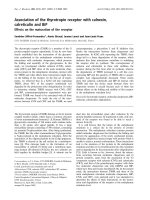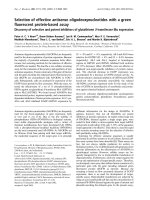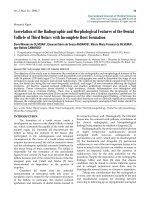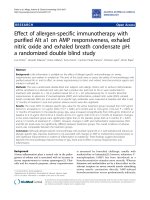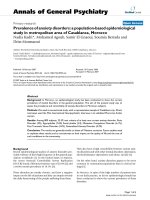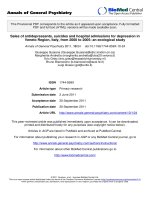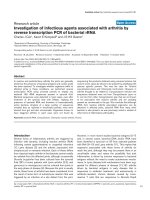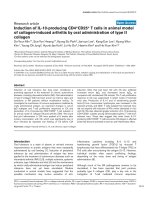Báo cáo y học: "Correlation of exhaled breath temperature with bronchial blood flow in asthma" pptx
Bạn đang xem bản rút gọn của tài liệu. Xem và tải ngay bản đầy đủ của tài liệu tại đây (505.42 KB, 10 trang )
BioMed Central
Page 1 of 10
(page number not for citation purposes)
Respiratory Research
Open Access
Research
Correlation of exhaled breath temperature with bronchial blood
flow in asthma
Paolo Paredi, Sergei A Kharitonov and Peter J Barnes*
Address: Department of Thoracic Medicine, National Heart and Lung Institute, Faculty of Medicine, Imperial College, London, UK
Email: Paolo Paredi - ; Sergei A Kharitonov - ; Peter J Barnes* -
* Corresponding author
asthmanitric oxidetemperaturebronchial blood flowinflammation.
Abstract
In asthma elevated rates of exhaled breath temperature changes (∆e°T) and bronchial blood flow
(Q
aw
) may be due to increased vascularity of the airway mucosa as a result of inflammation.
We investigated the relationship of ∆e°T with Q
aw
and airway inflammation as assessed by exhaled
nitric oxide (NO). We also studied the anti-inflammatory and vasoactive effects of inhaled
corticosteroid and β
2
-agonist.
∆e°T was confirmed to be elevated (7.27 ± 0.6 ∆°C/s) in 19 asthmatic subjects (mean age ± SEM,
40 ± 6 yr; 6 male, FEV
1
74 ± 6 % predicted) compared to 16 normal volunteers (4.23 ± 0.41 ∆°C/
s, p < 0.01) (30 ± 2 yr) and was significantly increased after salbutamol inhalation in normal subjects
(7.8 ± 0.6 ∆°C/ s, p < 0.05) but not in asthmatic patients. Q
aw
, measured using an acetylene dilution
method was also elevated in patients with asthma compared to normal subjects (49.47 ± 2.06 and
31.56 ± 1.6 µl/ml/min p < 0.01) and correlated with exhaled NO (r = 0.57, p < 0.05) and ∆e°T (r
= 0.525, p < 0.05). In asthma patients, Q
aw
was reduced 30 minutes after the inhalation of
budesonide 400 µg (21.0 ± 2.3 µl/ml/min, p < 0.05) but was not affected by salbutamol.
∆e°T correlates with Q
aw
and exhaled NO in asthmatic patients and therefore may reflect airway
inflammation, as confirmed by the rapid response to steroids.
Asthma is an inflammatory disease of the airways.
Vasodilatation is a critical feature of inflammation, and
angiogenesis and vascular remodelling are features of
chronic inflammatory diseases, such as asthma [1]. The
increased vascularity of the airways in asthma [2] is partly
due to the elevated number of vessels associated with ang-
iogenesis and partly due to vasodilation caused by the
release of vasodilator mediators, such as, histamine,
bradykinin [3], and nitric oxide (NO) [4]. In a recent
study we have found that patients with asthma have
higher increases of exhaled breath temperature (∆e°T)
compared with normal subjects and that this is correlated
to the concentration of exhaled nitric oxide (NO) [5].
Therefore, we suggested that patients with asthma have
high ∆e°T. and that this may be due to airway inflamma-
tion and elevated levels of NO. In the present study we
hypothesise that elevated ∆e°T may result from increased
heat exchange in the airways due to elevated bronchial
blood flow (Q
aw
) caused by inflammation and airway
remodelling. To test this, we investigate the relationship
Published: 10 February 2005
Respiratory Research 2005, 6:15 doi:10.1186/1465-9921-6-15
Received: 04 November 2004
Accepted: 10 February 2005
This article is available from: />© 2005 Paredi et al; licensee BioMed Central Ltd.
This is an Open Access article distributed under the terms of the Creative Commons Attribution License ( />),
which permits unrestricted use, distribution, and reproduction in any medium, provided the original work is properly cited.
Respiratory Research 2005, 6:15 />Page 2 of 10
(page number not for citation purposes)
between airway inflammation as assessed by exhaled NO,
with Q
aw
and ∆e°T measured non-invasively. Q
aw
is an
expression of bronchial blood flow, whereas ∆e°T reflects
the rate of temperature increase in the exhaled breath. We
hypothesised that Q
aw
changes may contribute to the lev-
els of ∆e°T and we studied their relationship considering
that, potentially, minor changes of bronchial blood flow
may not affect exhaled breath temperature.
Elevated levels of exhaled NO in asthma [6,7] are likely to
be due to the activation of the inducible form of NO syn-
thase (iNOS) by inflammatory cytokines [8] and there-
fore, reflect airway inflammation. Because NO also
regulates bronchial vascular tone [9] and may increase
bronchial blood flow [10,11] we measured its concentra-
tion in the exhaled breath as a marker of inflammation
and we analysed its relationship with Q
aw
and ∆e°T.
The measurement of Q
aw
is non-invasive and was stand-
ardised and adapted from a previously validated tech-
nique [12,13]. ∆e°T and bronchial blood flow (Q
aw
) were
also measured non-invasively allowing us to make
repeated measurements and to study the interactions of
these two markers and exhaled NO.
The inhalation of corticosteroids has been shown to have
an acute vasocostrictive effect on the bronchial circulation
[14] and the measurement of Q
aw
has been advocated to
assess airway steroid sensitivity. In order to evaluate fur-
ther the correlation of Q
aw
and ∆e°T with inflammation,
we studied the acute effect of inhaled budesonide on these
parameters and their reciprocal changes. Furthermore, to
validate our methods, we also evaluated the vasodilating
effect of the short-acting β
2
-agonist salbutamol.
Methods
Patients
Nineteen asthmatic patients were studied (7 male, age 40
± 5 yr, FEV
1
74 ± 6 %, 9 patients were on inhaled steroid
treatment and 10 patients had mild persistent asthma and
were on β
2
-agonist inhalers only). These two groups of
patients were chosen because they are representative of
the larger majority of asthmatic patients; in addition this
allowed us to verify cross sectionally the effect of inhaled
steroids on bronchial blood flow and exhaled NO.
We also examined 16 control subjects (age 30 ± 2 yr, 8
male) recruited from our outpatient clinic and from vol-
unteers (Table 1). Most of these subjects had previously
taken part in other published studies. The diagnosis of
asthma was established in each patient according to
American Thoracic Society criteria [15]. Patients with
acute chest infection or disease exacerbation during the
month before enrolment were excluded. Patients with his-
tory of diabetes, liver disease, heart failure, lung cancer, or
alcohol/drug abuse were not eligible for the study. All
subjects were life-long non-smokers. All asthmatic
patients refrained from using β
2
agonists and corticoster-
oids for at least 12 h prior to the study. The tests were car-
ried out at ambient temperature between 23 and 25C°
and humidity 60% and 65%.
Study design
The study was approved by the Brompton and Harefield
NHS trust Ethics Committee. After a clinical examination
was carried out, ∆e°T, Q
aw
and exhaled NO were meas-
ured at least after one hour of rest in the laboratory. This
was followed by spirometry.
Eight asthmatic subjects and eight normal volunteers
agreed to have ∆e°T and Q
aw
measured after the
inhalation of budesonide 400 µg and salbutamol 200 µg
or placebo, which were administered in three different vis-
Table 1: PATIENT CHARACTERISTICS
Asthma not steroid treated (n = 10) Steroid treated asthma (n = 9) Normals (n = 16)
Age (years) 37 ± 7 45 ± 7 30 ± 2
Sex (M/F) 4/6 3/6 8/8
FEV
1
(% predicted) 93 ± 10 75 ± 11 97 ± 9
Smokers 0 0 0
Ex smokers 0 0 0
Therapy:
Inhaled β-drenergics 10 10 0
Theophylline 0 0 0
Inhaled steroids 0 10 0
Oral steroids 0 0 0
Definition of abbreviations:; FEV
1
= forced expiratory volume in one second. Values are means ± SEM.
Respiratory Research 2005, 6:15 />Page 3 of 10
(page number not for citation purposes)
its. The measurements were repeated every 15 minutes for
1 h after budesonide and placebo inhalation and at base-
line and every 10 minutes for half an hour after the inha-
lation of salbutamol.
Exhaled breath temperature measurement
During a flow and pressure controlled single breath exha-
lation exhaled breath temperature gradients were meas-
ured as previously described [5]. As previously shown [5],
during a flow and pressure controlled exhalation from
total lung capacity through a 2.77 mm mouthpiece[16]
exhaled breath temperature was measured by a fast
response (1 ms) high accuracy (0.015 ± 0.027°C), ther-
mometer (Picotech Ltd) interfaced with a computer by a
single channel Picotech Oscilloscope (model ADC 42, res-
olution 12 bits) allowing online recording of exhaled
breath temperature.
In a preliminary study exhaled breath temperature trac-
ings were analyzed mathematically. The tracings proved
to have an exponential rise and the point at 63% of the
total temperature increase was chosen to study the slope
of the curves because it represents two time constants of
the maximal °T change and therefore allows a better
mathematical characterization of the tracings before
plateau.
The time constant of the thermometer response was
found by measuring the time for the temperature to reach
63% of the final reading. This avoided large errors in esti-
mating when the asymptotic final reading had been
reached.
The exhaled breath temperature changes exponentially
with time. The shape of the curve depends upon the time
constant (T). In one time constant the response reaches
63% of its final change.
The response is of the form
Where V
2
is the final value, V
1
the initial value, and t is the
time after exhalation was started. As t > infinity, the expo-
nential term > 0. Hence the response rises asymptotically
to its final value. When performing experiments to deter-
mine the time response of a system, it is difficult to tell at
which time the final value is obtained, since there will be
a small change in the response for a relatively long time as
the asymptote is approached. Jitter and noise in the signal
will also add to this problem. It is easier to estimate the
asymptotic value and find the time at which a certain per-
centage of this is reached. Various percentages are possi-
ble, the most commonly used in physics and biology is
the time constant, although in some applications (particu-
larly electronic engineering) the rise time to 95% of the
final value is used.
The 63% arises because when t = T, the expression above
becomes
(V
2
-V
1
)(1-1/e) = (V
2
-V
1
)(1-0.37) = 0.63(V
2
-V
1
)
In n time constants the percentage reached is 100 × (1-1/
e
n
)
which, approaches 98% after about 5 time constants.
The rate of temperature increase (∆e°T) calculated
between the beginning of exhalation and 63 % of the total
temperature increase (a/b, where "a" is 63% of ∆°T and
"b" the time to reach "a") proved to be the more reproduc-
ible parameter to characterize the curves.
We evaluated the effect of different exhalation flow rates,
distance of the thermocouple from the edge of the mouth-
piece and ambient temperature on ∆e°T and end-expira-
tory plateau temperatures. We found that ∆e°T but not
plateau temperatures were elevated at low (2–3 L/min)
compared to higher (5–6 L/min) exhalation flow rates
(6.25 ± 0.4°C/s and 4.45 ± 0.8°C/s, p < 0.01) in 8 normal
subjects. When the thermocouple was inserted close to the
edge of the mouthpiece (1 cm) the ∆e°T was significantly
higher (7.15 ± 0.2°C/s) compared to when it was located
farther (2 cm) (4.45 ± 0.8°C/s, p < 0.01). There was a ten-
dency for faster ∆e°T when the subjects were starting
exhaling from higher baseline ambient temperatures but
this was not significant for temperature changes within ±
3°C (5.05 ± 0.8°C/s at 28°C and 4.45 ± 0.8°C/s at 22°C
p > 0.05). The volume ventilation did not influence the
∆e°T value. The difference in exhaled breath ∆e°T and
plateau temperatures measured during two successive col-
lections at five minutes intervals (single session variabil-
ity) was 4.4%, while between sessions variability (n = 6,
one day interval) was 6.8%. The reproducibility of the test
was confirmed by the Bland and Altman test [17].
Exhaled NO measurements
Exhaled NO was measured using a modified chemilumi-
nescence analyzer (model LR2000; Logan Research,
Rochester, Kent) as previously described [18].
Bronchial blood flow
We modified a previously validated soluble inert gas
uptake method to measure Q
aw
, using acetylene rather
than the potentially explosive dimethylether [12,13]. The
subjects were sitting in front of a valve system inhaling
through a mouthpiece (with nose clips on) initially room
air and then a gas mixture from a Teflon bag containing
Vt V V
t
T
()
=−
()
−
−
21
1( exp )
()
Respiratory Research 2005, 6:15 />Page 4 of 10
(page number not for citation purposes)
35% O2, 0,3% acetylene, 5% sulphur hexafluoride, CO
3% and a balance of nitrogen. During the exhalation the
concentration of acetylene was measured directly online
by a mass spectrometer, and Q
aw
was calculated from the
Fick principle (dilution of acetylene concentration) (Fig-
ure 1), the area under the curve (AUC) being inversely
proportional to the bronchial blood flow. Q
aw
was
expressed as µl/ml/min representing the volume of blood
per volume of dead space per time.
Previous studies have used dimethyl ether instead of acet-
ylene for the measurement of bronchial blood flow. In the
current study we used acetylene because of the higher
explosive potential of dimethylether when in contact with
O
2
. This method was previously validated in the sheep
where the invasive inoculation of radioactive micro
spheres directly into the bronchial circulation provided
similar results [19]. The use of micro spheres is considered
the Gold Standard for the measurement of blood flow,
however, this method is invasive and presents limitations
such as the recirculation of the radioactive spheres.
Acetylene and diethyl ether present similar blood solubil-
ity and affinity for haemoglobin when measured at the
same temperature [20]. Gas exchange efficiency is largely
dependent on solubility. Because these two gases have
similar physicochemical characteristics we assume that
they can be used interchangeably. This is further
confirmed by the finding of a similar range of bronchial
blood flow and similar response to corticosteroids (vaso-
Method for the measurement of bronchial blood flow (Q
aw
)Figure 1
Method for the measurement of bronchial blood flow (Q
aw
). Subjects inhale 60% of their vital capacity from a reservoir con-
taining acetylene 0.3% and then exhale into a mass spectrometer (Panel A). Panel B shows a tracing of acetylene, the area
under the curve, corresponding to the conducting airways, is proportional to airway blood flow.
i
Ambient
air
Respiratory
valve
Rebreathing
bag (acetylene 0.3%)
0DVV
0DVV0DVV
0DVV
VSHFWURPHWHU
VSHFWURPHWHUVSHFWURPHWHU
VSHFWURPHWHU
0.0
0.1
0.2
0.3
0
1000 2000
3000
Time (ms)
Acetylene (%)
'HDG
'HDG'HDG
'HDG
VSDFH
VSDFHVSDFH
VSDFH
/XQJ
/XQJ/XQJ
/XQJ
SDUHQFK\PD
SDUHQFK\PDSDUHQFK\PD
SDUHQFK\PD
$8&SURSRUWLRQDOWR
DFHW\OHQHXSWDNH
([KDODWLRQ
([KDODWLRQ([KDODWLRQ
([KDODWLRQ
i
Ambient
air
Respiratory
valve
Rebreathing
bag (acetylene 0.3%)
0DVV
0DVV0DVV
0DVV
VSHFWURPHWHU
VSHFWURPHWHUVSHFWURPHWHU
VSHFWURPHWHU
0.0
0.1
0.2
0.3
0
1000 2000
3000
Time (ms)
Acetylene (%)
'HDG
'HDG'HDG
'HDG
VSDFH
VSDFHVSDFH
VSDFH
/XQJ
/XQJ/XQJ
/XQJ
SDUHQFK\PD
SDUHQFK\PDSDUHQFK\PD
SDUHQFK\PD
$8&SURSRUWLRQDOWR
DFHW\OHQHXSWDNH
([KDODWLRQ
([KDODWLRQ([KDODWLRQ
([KDODWLRQ
Respiratory Research 2005, 6:15 />Page 5 of 10
(page number not for citation purposes)
constriction) and beta 2 agonists (vasodilatation) in this
study compared to previously published studies which
used the dimethyl ether method.
Statistics
Comparisons between groups were made by one-way
analysis of variance (ANOVA) Data were expressed as
means ± standard error of mean. The relationship
between the exhaled breath temperature, Q
aw,
NO and
FEV
1
were tested with the linear correlation coefficient.
Results
Bronchial blood flow (Q
aw
)
Q
aw
was elevated to a similar extent in patients with mild
persistent and moderate asthma (on regular inhaled corti-
costeroids and β
2
-agonists) (46.0 ± 51 µl/ml/min) and
patients with mild intermittent asthma (on β
2
-agonists as
needed only) (52.64 ± 3.0 µl/ml/min, p > 0.05) compared
to normal subjects (31.56 ± 1.6 µl/ml/min, p < 0.01, Fig-
ure 2, Panel A). Q
aw
was correlated with exhaled NO (r =
0.57, p < 0.05, Figure 3, Panel A) and ∆e°T (r = 0.52, p <
0.05, Figure 3, Panel B).
Exhaled air temperature
∆e°T was higher in asthmatic patients (7.27 ± 0.6 ∆°C/
sec) compared to normal subjects (4.23 ± 0.41 ∆°C/ sec,
p < 0.01, Figure 2, Panel B) and was not statistically differ-
ent in steroid treated (7.56 ± 0.99 ∆°C/ sec) compared to
untreated patients (6.83 ± 0.78 ∆°C/ sec, p > 0.05).
Levels of bronchial blood flow (Q
aw
) (Panel A) and exhaled breath temperature gradients (∆e°T) (Panel B) in normal subjects (ᮀ) and patients with asthma (•)Figure 2
Levels of bronchial blood flow (Q
aw
) (Panel A) and exhaled breath temperature gradients (∆e°T) (Panel B) in normal subjects
(ᮀ) and patients with asthma (•).
10
20
30
40
50
60
70
80
Normal
Asthmatic
p< 0.05
Q
°
°
°
°
aw
(
µ
µ
µ
µ
l/min/ml)
0
5
10
15
20
Normal
Asthma
p< 0.05
∆
∆
∆
∆
e
°
°
°
°
T (
∆
∆
∆
∆
°C / s e c )
Panel A
Panel B
Respiratory Research 2005, 6:15 />Page 6 of 10
(page number not for citation purposes)
Exhaled NO
NO levels were elevated in asthmatic subjects not on ster-
oid treatment (15.6 ± 2.8 ppb) compared to steroid
treated patients (7.5.6 ± 2.3 ppb, p < 0.05) and normal
subjects (4.7 ± 0.3 ppb, p < 0.05).
Effect of budesonide and salbutamol inhalation
Bronchial blood flow
In asthmatic patients Q
aw
was significantly reduced 30
minutes after the inhalation of budesonide compared to
baseline (53.0 ± 5.0 µl/ml/min and 21.3 ± 2.32 µl/ml/
min respectively, p < 0.05 Figure 4 Panel A) and returned
to baseline levels at 60 minutes (52.6 ± 4.0 µl/ml/min). In
normal subjects there was a tendency for lower Q
aw
after
the inhalation of budesonide but such changes were not
significant (30.3 ± 5.0 µl/ml/min and 26.3 ± 3.0 µl/ml/
min at baseline and at 30 minutes respectively, p > 0.05,
n = 5, Figure 4 Panel A).
In 8 normal volunteers Q
aw
was increased after salbuta-
mol inhalation (32.3 ± 8.1 µl/ml/min and 55.0 ± 3.0 µl/
ml/min at baseline and at 10 minutes respectively, p <
0.05), while this effect was not present in asthmatic
patients (54.0 ± 7.0 µl/ml/min and 52.0 ± 6.0 µl/ml/min,
p > 0.05, n = 5, Figure 4 Panel B).
Placebo had no effect on Q
aw
in subjects with asthma
(54.0 ± 3.0, 56.1 ± 4.5 and 53.1 ± 8.1 µl/min/ml/ at base-
Correlation of bronchial blood flow (Q
aw
) with exhaled nitric oxide (NO) (Panel A) and exhaled breath temperature gradients (∆e°T) (Panel B) in patients with asthmaFigure 3
Correlation of bronchial blood flow (Q
aw
) with exhaled nitric oxide (NO) (Panel A) and exhaled breath temperature gradients
(∆e°T) (Panel B) in patients with asthma.
0 25 50 75 100 125
0
10
20
30
r=0.57
p<0.05
Q°
°°
°
aw
(µ
µµ
µl/ mi n/ ml)
Exhaled NO (ppb)
0 25 50 75 100 125
0
5
10
15
20
r=0.52
p<0.05
Q°
°°
°
aw
(µ
µµ
µl/ min/ ml)
∆
∆
∆
∆
e
°
°
°
°
T (
∆
∆
∆
∆
°C / s e c )
Panel A
Panel B
Respiratory Research 2005, 6:15 />Page 7 of 10
(page number not for citation purposes)
line, 30 and 60 minutes respectively, p > 0.05) nor in nor-
mal subjects (34.0 ± 3.0,38.1 ± 4.5 and 35.1 ± 8.1 µl/min/
ml/ p > 0.05)
Exhaled breath temperature
The inhalation of budesonide was associated with a ten-
dency for a decrease of ∆e°T in asthmatic patients (from
10.17 ± 2 ∆°C/ sec at baseline to 8.6 ± 3 ∆°C/sec 30 min-
utes after inhalation Figure 5 Panel A), even though this
decrease was not significant; the changes in Q
aw
and ∆e°T
were correlated in asthmatic patients (r = 0.78, p < 0.05).
In normal subjects, no significant changes of ∆e°T were
found at any of the time points after budesonide inhala-
tion (3.5 ± 2 ∆°C/sc at baseline, 3.5 ± 1 ∆°C/sc at 30 min-
utes, 3.53 ± 2 ∆°C/sc at 60 minutes, p > 0.05).
In 5 normal volunteers ∆e°T was increased after the inha-
lation of 200 µg of salbutamol (3.50 ± 0.29 ∆°C/ sec and
7.8 ± 0.6 ∆°C/ sec, p < 0.01), while this effect was not
present in asthmatic patients (10.1 ± 0.44 ∆°C/ sec and
9.67 ± 0.51 ∆°C/ sec, p > 0.05, n = 5, Figure 5 Panel B)
∆e°T was unchanged in subjects with asthma (9.17 ± 2
and 10.23 ± 3.5 ∆°C/ sec at baseline and 10 minutes
respectively, p > 0.05) and in normal subjects (3.50 ± 0.29
∆°C/ sec and 4.20 ± 0.32 ∆°C/ sec p > 0.05) after the inha-
lation of placebo.
Discussion
This is the first study to show that elevated levels of Q
aw
and ∆e°T are correlated with one another and with airway
inflammation as assessed by exhaled NO. We propose
that high levels of NO generated in asthmatic patients as
a result of airway inflammation may cause vasodilatation
of the bronchial circulation contributing to increased heat
exchange. This is supported by the demonstration that
Acute effect of budesonide inhalation (400 µg) (Panel A) and salbutamol (200 µg) (Panel B) on bronchial blood flow (Q
aw
)Figure 4
Acute effect of budesonide inhalation (400 µg) (Panel A) and salbutamol (200 µg) (Panel B) on bronchial blood flow (Q
aw
).
0 10 20 30 40
0
25
50
75
Asthma
Nor mal
**
Salbutamol
Time (minutes)
** **
Q
q
aw
(
P
l/min/ml)
0 15 30 45 60 75
0
25
50
75
Budesonide.
**
Normal
Asth ma
Time (minutes)
Q
q
aw
(
P
l/min/ml)
Panel A
Panel B
Respiratory Research 2005, 6:15 />Page 8 of 10
(page number not for citation purposes)
lower ∆e°T levels, after the inhalation of corticosteroids,
are correlated with reduced levels of bronchial blood
flow. We propose that these non-invasive measurements
may be useful to evaluate airway inflammation and may
provide a tool to assess steroid sensitivity.
Angiogenesis and microvascular remodelling are features
of chronic inflammatory diseases, such as asthma [21]. As
inflammatory diseases evolve, the microvasculature
undergoes progressive changes in structure and function.
Blood vessels enlarge and proliferate supplying inflamma-
tory cells in chronically inflamed tissues. Because of these
changes, asthmatic patients have increased vascularity of
the airway mucosa which is related to the severity of the
disease [2]. Airway vascular remodelling and inflamma-
tion maybe responsible for increased bronchial blood
flow [22] and exhaled breath temperature gradients in
asthmatic patients [5].
In a previous study [23] we have proved that patients with
asthma have elevated ∆e°T compared to normal subjects
and because we found a significant correlation with
exhaled NO we suggested that this was due to airway
inflammation. In the present study we hypothesised that
∆e°T is elevated in asthma as a result of increased bron-
chial blood flow and we studied the relationship between
Q
aw
and ∆e°T and airway inflammation as assessed by
exhaled NO. Even though the patients enrolled in this
study were significantly older than the control group, our
previous studies [5,24] indicate that that age does not
affect ∆e°T. We studied airway inflammation measuring
exhaled NO and we investigates its relationship with Q
aw
which has also been suggested as a marker of inflamma-
Acute effect of budesonide inhalation (400 µg) (Panel A) and salbutamol (200 µg) (Panel B) on exhaled breath temperature gra-dients (∆e°T)Figure 5
Acute effect of budesonide inhalation (400 µg) (Panel A) and salbutamol (200 µg) (Panel B) on exhaled breath temperature gra-
dients (∆e°T).
0 10 20 30 40
0
5
10
15
Normal
Asthma
**
**
Time (minutes)
'
e
q
T (
'
°C/sec)
**
Salbutamol
0 15 30 45 60 75
0
5
10
15
Normal
As thma
Budesonide.
Time (minutes)
'
e
q
T (
'
°C/sec)
Panel A
Panel B
Respiratory Research 2005, 6:15 />Page 9 of 10
(page number not for citation purposes)
tion. We also studied the interaction of these two param-
eters after inhaled corticosteroids β
2
agonists.
We confirmed previous data showing elevated levels of
Q
aw
in asthmatic subjects compared to normal volunteers,
using a modified method developed by Onorato et al [25].
In the current study we preferred the use of acetylene over
dimethyl ether because the latter is highly explosive when
in contact with oxygen. Gas exchange efficiency is largely
dependent on solubility, because these two gases have
similar physicochemical characteristics we assume that
they can be used interchangeably. Furthermore, the meas-
urement of Q
aw
in this study presented the same response
pattern and timing to the inahaltion of steroids [12] and
beta agonists [26] as previously showed using the dime-
thyl ether method confirming that the method presented
in our study is an acceptable measurement of Q
aw
.
The method used in this study for the measurement of
Q
aw
produces results which include the contribution of
the dead space and trachea blood flow to the total bron-
chial blood flow. We acknowledge that the trachea may
not be the main site of inflammation in asthma, but
inflammation in asthma extends from the larynx to the
terminal bronchioles and the tracheal mucosa certainly
appears inflamed in many asthmatic patients. When tra-
cheal inflammation occurs there will be a good separation
between normal subjects and patients with asthma
because the measurements of bronchial blood flow and
exhaled breath temperature will particularly reflect the
contribution of this part of the respiratory tract
For the first time we have shown, using non-invasive
methods, that changes in bronchial blood flow can alter
exhaled breath temperature indicating that the bronchial
circulation may control airstream temperature. Further-
more, in this study not only we have shown a correlation
between Q
aw
and ∆e°T but we have also shown that these
measurements respond similarly to steroids and beta 2
agonists. Therefore, patients with asthma have a signifi-
cantly faster rise of breath temperature and Q
aw
and these
are correlated. We presume that this is due to the
increased vascularity of the bronchial vessels [27] and ele-
vated blood supply and therefore heat transfer across the
bronchial wall. Hyperaemia and hyperperfusion are con-
sistent features of tissue inflammation, therefore, the find-
ing of increased exhaled air temperature and bronchial
blood flow in asthmatic patients may be due to the ele-
vated levels of exhaled NO which is a marker of inflam-
mation and a potent bronchial vasodilator. Even though
the correlation between Q
aw
and ∆e°T may appear to be
weak, it is noteworthy that the acute changes of these var-
iable was significantly correlated, reinforcing the hypoth-
esis that elevated breath temperature gradients in
asthmatic patients may reflect increased bronchial blood
flows.
We were able to show a positive correlation between
exhaled NO and ∆e°T. NO is a gas produced by several
types of pulmonary cells, including inflammatory,
endothelial and airway epithelial cells. Elevated levels of
exhaled NO in asthma [6], and interstitial lung disease
[28] are likely to be due to the activation of the inducible
form of NO synthase (iNOS) and therefore may reflect air-
way inflammation, alternatively NO maybe produced by
the bronchial epithelium. In addition the activity of
iNOS, the inducible enzyme responsible for the synthesis
of NO, is temperature-dependent [29], therefore elevated
airway temperatures in patients with asthma [5] may
induce further synthesis of NO. NO is a potent vasodilator
and may play a role in the regulation of bronchial vaso-
motor tone [10], so that elevated levels of NO may lead to
vasodilatation and increased bronchial blood flow as
shown by the correlation between exhaled NO and ∆e°T.
Unfortunately, in the current study, we were unable to
establish the contribution of NO produced by the bron-
chial vasculature compared to the pulmonary circulation.
In this cross-sectional study we could not show any differ-
ences of ∆e°T or Q
aw
in corticosteroid-treated compared
to untreated asthmatic patients, despite the efficacy of
steroids in reducing bronchial blood flow [12]. This is
consistent with previous studies published by our group
and others showing that steroid-treated asthmatic patients
have similar ∆e°T [5] and Q
aw
[22] compared to untreated
patients. One hypothesis is that the vasoconstrictive
action of inhaled corticosteroids may have been balanced
by β
2
induced vasodilatation resulting in minimal
changes in bronchial artery diameter and blood flow and
therefore no changes of Q
aw
and ∆e°T. However, these
results must be confirmed by placebo controlled studies.
In contrast to the effect of chronic treatment with corticos-
teroids, the acute inhalation of budesonide caused a sig-
nificant temporary reduction of Q
aw
which returned to
baseline one hour after inhalation. This is also consistent
with a previous publication [22], notably, in the current
study Q
aw
and ∆e°T and their interaction were studied
simultaneously in the same group of patients for the first
time. Corticosteroids may cause vasoconstriction by
numerous mechanisms. They can potentiate the vasocon-
strictor actions of noradrenalin and angiotensin II by
upregulating their vascular receptors [30]. Furthermore,
corticosteroids may inhibit the synthesis of NO [31], thus
causing vasoconstriction. In addition to these
mechanisms of action, corticosteroids may also have a
very rapid action (less than 5 minutes) by inhibiting
noradrenalin uptake in bronchial blood vessels [32]. The
glucocorticoid-induced vasoconstriction in asthmatics
Respiratory Research 2005, 6:15 />Page 10 of 10
(page number not for citation purposes)
seems to be accompanied by a greater α
1
-adrenergic vaso-
constrictor response [26]. This adds further support to a
α
1
-adrenergic steroid interplay in the regulation of vascu-
lar tone.
Further studies are required, investigating the dose
response relationship for inhaled steroids would provide
valuable information.
The cardinal signs of inflammation are rubor (redness),
calor (heat), tumor (swelling), dolor (pain), and impaired
function (functio laesa). Exhaled breath temperature and
bronchial blood flow may reflect rubor and calor in the
airways and therefore may be markers of tissue inflamma-
tion and remodelling as confirmed by the positive corre-
lation between ∆e°T, Q
aw
and exhaled NO which was
shown for the first time in this study. Measurement of
exhaled breath temperature and bronchial blood flow
may provide means of detecting airway inflammation and
vascular remodelling in a non-invasive way.
Acknowledgments
This study was supported by the National Heart and Lung Institute, London
UK No Part of the research presented was founded by tobacco industry
sources
References
1. Vignola AM, Mirabella F, Costanzo G, Di Giorgi R, Gjomarkaj M, Bellia
V, Bonsignore G: Airway remodeling in asthma. Chest 2003,
123:417S-422S.
2. Salvato G: Quantitative and morphological analysis of the vas-
cular bed in bronchial biopsy specimens from asthmatic and
non-asthmatic subjects. Thorax 2001, 56:902-906.
3. Parsons GH, Nichol GM, Barnes PJ, Chung KF: Peptide mediator
effects on bronchial blood velocity and lung resistance in
conscious sheep. J Appl Physiol 1992, 72:1118-22.
4. Charan NB, Johnson SR, Lakshminarayan S, Thompson WH, Carvalho
P: Nitric oxide and beta-adrenergic agonist-induced bron-
chial arterial vasodilation. J Appl Physiol 1997, 82:686-692.
5. Paredi P, Kharitonov SA, Barnes PJ: Faster rise of exhaled breath
temperature in asthma: a novel marker of airway
inflammation? Am J Respir Crit Care Med 2002, 165:181-184.
6. Kharitonov SA, Yates D, Robbins RA, Logan-Sinclair R, Shinebourne
EA, Barnes PJ: Increased nitric oxide in exhaled air of asth-
matic patients. Lancet 1994, 343:133-135.
7. Lanz MJ, Leung DY, McCormick DR, Harbeck R, Szefler SJ, White
CW: Comparison of exhaled nitric oxide, serum eosinophilic
cationic protein, and soluble interleukin-2 receptor in exac-
erbations of pediatric asthma. Pediatr Pulmonol 1997, 24:305-311.
8. Robbins RA, Springall DR, Warren JB, et al.: Inducible nitric oxide
synthase is increased in murine lung epithelial cells by
cytokine stimulation. Biochem Biophys Res Commun 1994,
203:209-18.
9. Cremona G, Wood AM, Hall LW, Bower EA, Higenbottam T: Effect
of inhibitors of nitric oxide release and action on vascular
tone in isolated lungs of pig, sheep, dog and man. J Physiol
(Lond) 1994, 481:185-195.
10. Fagan KA, Tyler RC, Sato K, Fouty BW, Morris KGJ, Huang PL,
McMurtry IF, Rodman DM: Relative contributions of endothe-
lial, inducible, and neuronal NOS to tone in the murine pul-
monary circulation. Am J Physiol 1999, 277:L472-L478.
11. Degnim AC, Nakayama DK: Nitric oxide and the pulmonary
artery smooth muscle cell. Semin Pediatr Surg 1996, 5:160-164.
12. Brieva JL, Danta I, Wanner A: Effect of an Inhaled Glucocorticos-
teroid on Airway Mucosal Blood Flow in Mild Asthma. Am J
Respir Crit Care Med 2000, 161:293-296.
13. Chediak AD, Elsasser S, Csete ME, Gazeroglu H, Wanner A: Effect
of histamine on tracheal mucosal perfusion, water content
and airway smooth muscle in sheep. Respir Physiol 1991,
84:231-243.
14. Mendes ES, Pereira A, Danta I, Duncan RC, Wanner A: Compara-
tive bronchial vasoconstrictive efficacy of inhaled
glucocorticosteroids. Eur Respir J 2003, 21:989-993.
15. Standards for the diagnosis and care of patients with chronic obstruc-
tive pulmonary disease (COPD) and asthma: This official state-
ment of the American Thoracic Society was adopted by the
ATS Board of Directors, November 1986. Am Rev Respir Dis
1987, 136:225-244.
16. Paredi P, Loukides S, Ward S, et al.: Exhalation flow and pressure-
controlled reservoir collection of exhaled nitric oxide for
remote and delayed analysis. Thorax 1998, 53:775-9.
17. Bland JM, Altman DG: Statistical methods for assessing agree-
ment between two methods of clinical measurement. Lancet
1986, 1:307-310.
18. Kharitonov S, Alving K, Barnes PJ: Exhaled and nasal nitric oxide
measurements: recommendations. The European Respira-
tory Society Task Force. Eur Respir J 1997, 10:1683-1693.
19. Scuri M, McCaskill V, Chediak AD, Abraham WM, Wanner A: Meas-
urement of airway mucosal blood flow with dimethylether:
validation with microspheres. J Appl Physiol 1995, 79:1386-1390.
20. Jibelian G, Mitchell RR, Overland ES: Influence of hematocrit and
temperature on solubility of acetylene and dimethyl ether. J
Appl Physiol 1981, 51:1357-1361.
21. McDonald DM: Angiogenesis and remodelling of airway vascu-
lature in chronic inflammation. Am J Respir Crit Care Med JID
2001, 164(10 Pt 2):S39-S45.
22. Kumar SD, Emery MJ, Atkins ND, Danta I, Wanner A: Airway
mucosal blood flow in bronchial asthma. Am J Respir Crit Care
Med 1998, 158:153-156.
23. Laitinen LA, Laitinen MA, Widdicombe JG: Dose-related effects of
pharmacological mediators on tracheal vascular resistance
in dogs. Br J Pharmacol 1987, 92:703-709.
24. Paredi P, Caramori G, Cramer D, Ward S, Kharitonov SA, Barnes PJ:
Slower rise of exhaled breath temperature in COPDSlower
rise of exhaled breath temperature in COPD. Eur Respir J 2003,
21:439-443.
25. Onorato DJ, Demirozu MC, Breitenbucher A, Atkins ND, Chediak
AD, Wanner A: Airway mucosal blood flow in humans.
Response to adrenergic agonists. Am J Respir Crit Care Med 1994,
149:1132-1137.
26. Brieva J, Wanner A: Adrenergic airway vascular smooth muscle
responsiveness in healthy and asthmatic subjects. J Appl Physiol
2001, 90:665-669.
27. Li X, Wilson JW: Increased vascularity of the bronchial mucosa
in mild asthma. Am J Respir Crit Care Med 1997, 156:229-233.
28. Paredi P, Kharitonov SA, Loukides S, Pantelidis P, du BR, Barnes PJ:
Exhaled nitric oxide is increased in active fibrosing alveolitis.
Chest 1999, 115:1352-1356.
29. Venturini G, Colasanti M, Fioravanti E, Bianchini A, Ascenzi P: Direct
effect of temperature on the catalytic activity of nitric oxide
synthases types I, II, and III. Nitric Oxide 1999, 3:375-382.
30. Ullian ME: The role of corticosteriods in the regulation of vas-
cular tone. Cardiovasc Res 1999, 41:55-64.
31. Redington AE, Meng QH, Springall DR, Evans TJ, Creminon C, Macl-
ouf J, Holgate ST, Howarth PH, Polak JM: Increased expression of
inducible nitric oxide synthase and cyclo-oxygenase-2 in the
airway epithelium of asthmatic subjects and regulation by
corticosteroid treatment. Thorax 2001, 56:351-357.
32. Horvath G, Lieb T, Conner GE, Salathe M, Wanner A: Steroid sen-
sitivity of norepinephrine uptake by human bronchial arte-
rial and rabbit aortic smooth muscle cells. Am J Respir Cell Mol
Biol 2001, 25:500-506.


